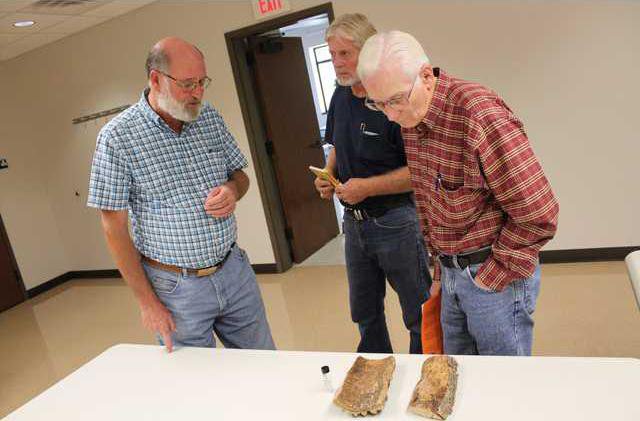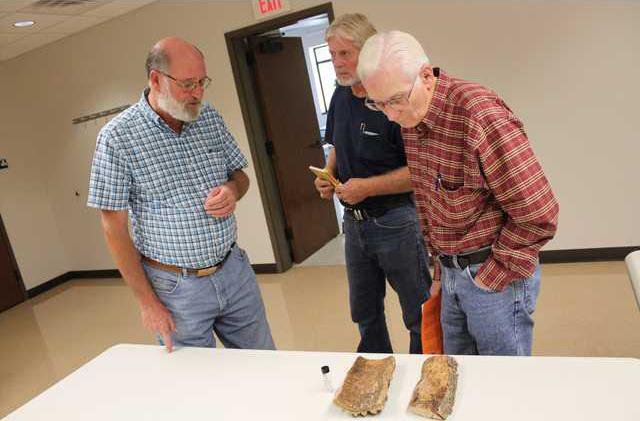Trees play an important role in the landscape, providing windbreaks and shade, as well as a place to string lights during the holidays. But after two years of drought and extreme heat trees are showing disturbing signs of distress, and even death.
“Even if they were really well watered, they suffered,” Kansas State Forest Service District Forester Jim Sterine said Wednesday when he visited Great Bend. “They really started suffering last year.”
At a noon program at the Great Bend Recreation Center, “Tree Diseases and Insects”,Sterine predicted current dry conditions would lead to more insect and disease problems affecting trees in the Great Bend area.
Conditions have already taken their toll on several species, weakening them and making them vulnerable to fungus and bacterial diseases. In theri weakended state, they’ve become inviting hosts to boring insects. Pine trees, especially, are being hit hard.
Disease and destruction
Tip Blight and Pine Wilt are two of the main culprits, Sterine said. Tip blight is a fungal disease that causes brown tips on the new growth of pine trees. It can affect any variety of pine, he said, but Austrian Pines are particularly vulnerable. If the tree is just beginning to display signs of blight, careful pruning and disposal of needles, cones, and prunings will help. The disease can take a few years to really get going. In order to not spread the fungus, Sterine warned guests to prune only when the tree is dry, cleaning tools in between each cut. For more severe infections, a professional can apply a fungicide to the entire tree, he said.
Pine Wilt, however, is very fast moving
“The tree dies in a hurry,” Sterine said. “I’ve seen a tree go from completely green to completely brown in a month.” The culprit is the pine wood nematode, passed from tree to tree by the Pine Sawyer beetle. When the beetle pierces the needles of the tree, it vectors the nematodes into the tree where they begin to destroy their host. They feed on sap, and have a very rapid reproduction rate. Within a month, they can become systemic in the tree. There is no cure once the tree is infected. Again, Austrian Pines and Scotts Pines are being hit hard. The disease entered the state in the east, and is working its way west, Sterine said. A Christmas tree farm southwest of Great Bend has been decimated by the disease.
“The best way to deal with Pine Wilt is to cut down and destroy the tree prior to the April-May emergence of the Pine Sawyer beetle,” Sterine said.
Different varieties of tiny bark beetles are also wreaking havoc on several other varieties trees.
“If a tree is healthy, its sap flow encases the boring insect and pitches it out,” he said. “If the tree is drought stressed, however, they can get in and wipe the tree out.”
One culprit, the Emerald Ash Beetle was introduced to the North American continent as recently as the early 1990s and has been labeled the most destructive forest insect introduced in recent history. It leaves a distinctive D-shaped hole where it bores into the bark of Ash trees, and proceeds to eat the cambium layer, located under the bark, with a voracious appetite. It is difficult to detect, and difficult to treat, according to the US Forest Service. Some systemic treatments with pyrethrum can be put in the soil when tree leaves are transpiring moisture. It takes time to build up in the tree’s system.
Currently, the USFS goal is to minimize the spread of the beetle, quarantine movement of ash logs and trees that have been harvested or destroyed, and help with reforestation efforts using more diverse species.
Not every hole, however, is from a bark boring beetle, Sterine said. Yellow-bellied sapsuckers, a variety of woodpecker, may be the culprit. Their holes will be evenly spaced, and their damage is minimal. The birds are migratory, and often travel through an area virtually undetected.
Prevention
Sterine said he has seen drought stress among cedar trees and windbreaks throughout the district. Dwarf Alberta Spruce, Yews and Colorado Blue Spruce tend to be shallow rooted or give off more moisture than they take in. He’s seen several dead or dying in the area.
“The problem is, the trees just run out of moisture,” he said.
He recommends deep watering trees by setting a soaker hose or sprinklers around the entire drip line of the tree, allowing water to seep to a depth of 18 inches. A thin metal rod or plastic stick can be easily inserted to the depth the water has saturated the ground, and is a good way to check the moisture level of the soil at any time, Sterine said.
“I can’t overemphasize the importance of watering in trees this time of year,” he said. Fertilizing, however, should only be done if necessary. “We don’t want to cause growth when energy is needed for defense. Insects actually seek out fertilized trees, we’ve found.”
Notable Natives
Replacing vulnerable trees that have died or are dying with a hardier variety is a good idea, he said. The following native pine varieties are better able to deal with the area’s extreme conditions, and therefore stand-up to infection or invasion better: Ponderosa Pine, Southwestern White Pine, Limber Pine, and if you have a lot of patience, slow-growing Pinyon Pine.
“It grows really slow, but it’s really hearty,” he said of the Pinyon.
Sterine’s favorite deciduous shade tree is the Burr Oak. He also recommends the London Plain, American Elm (new varieties are resistant to the Dutch Elm disease that killed many in the mid 20th century), and American Linden. The most drought resistant tree is the Common Hackberry, he said. For bright autumn reds, Caddo Sugar Maple “John Pair” is heat tolerant and very insect and disease resistant. All are readily available at commercial nurseries, he said.
Root to Tip
State forester advises prevention and treatment for weakened trees





